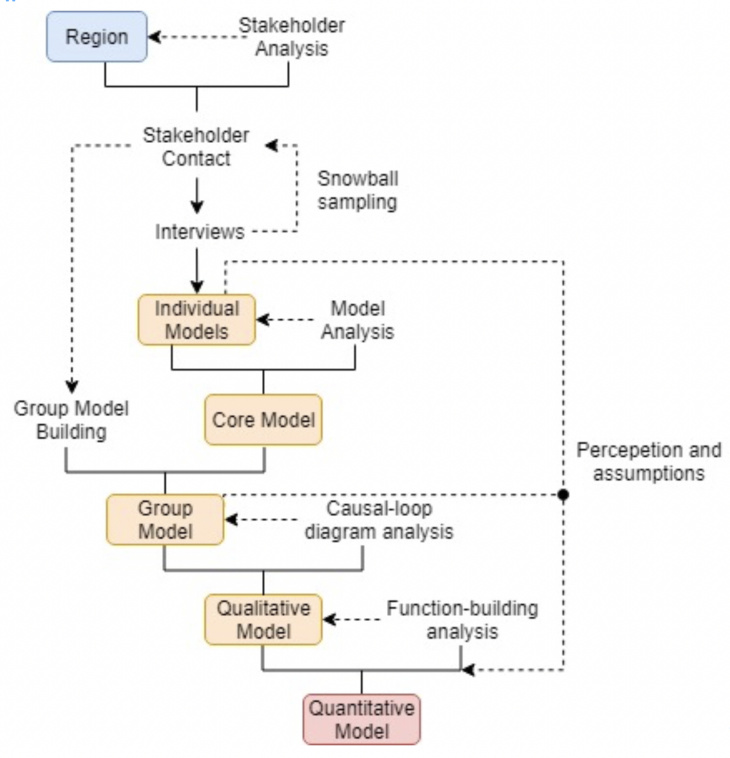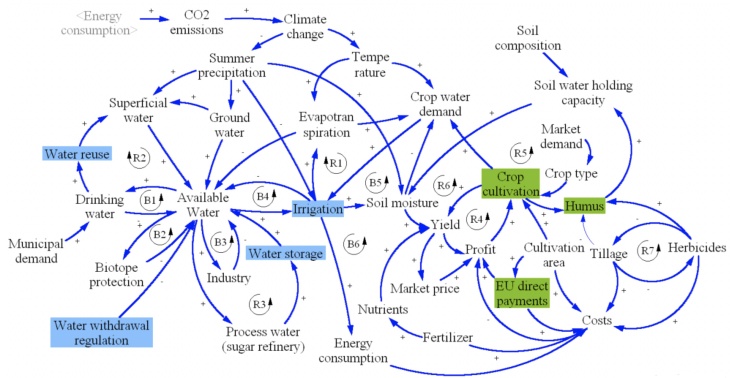Stage 1: Stakeholder engagement and qualitative model development (2018 – 2019)

Fig. 1: Sketch of the model building process
The aim of the first stage of the project was the co-development of a qualitative system dynamics model together with stakeholders. A sketch of the model building process including stakeholder engagement is presented in Fig. 1.
The IMLAND team carried out 20 individual interviews in the region of Northeast Lower Saxony (NELS) (Fig. 2).
The project partners included farmers, the chamber of agriculture, the farmers’ association, diverse governmental nature protection agencies and water management agencies. Afterwards, the team organized and conducted a Group Model Building workshop. The objective of this stage was to gain first-hand information on the structures and relationships between agriculture, water, politics and climate change. As a final result, the team co-developed a qualitative system dynamics (SD) model (Fig. 3) together with the project partners. The qualitative model served as a starting point to make a first analysis of feedback loops and leverage points (Fig. 2) that guide towards regional climate change adaptation measures. It provides the base for to develop a quantitative SD model.

Fig. 2: Interview with a farmer to co-develop an individual system dynamics model

As a final result, the team co-developed a qualitative system dynamics (SD) model (Fig. 3) together with the project partners. The qualitative model served as a starting point to make a first analysis of feedback loops and leverage points (Fig. 2) that guide towards regional climate change adaptation measures. It provides the base for to develop a quantitative SD model.
Papers
• Drought and water management under climate change in the German agricultural sector - a participatory system dynamics approach. Rodrigo Valencia-Cotera, Sabine Egerer, María Máñez-Costa (Under review)
• A leverage points analysis of a qualitative system dynamics model for climate change adaptation in agriculture. Sabine Egerer, Rodrigo Valencia-Cotera, María Máñez-Costa, Agricultural Systems (Under review)
Highlights
1. We developed a novel approach to identify leverage points of a qualitative system dynamics model.
2. This approach was applied to the agricultural sector in an irrigation intensive region in Germany.
3. Adaptation measures were inferred to effectively cope with regional water use conflicts.
4. The potential of stakeholders was assessed to implement adaptation measures.
Conference presentations
• EGU General Assembly, May 2020, Vienna (virtual conference) - Oral presentation by Valencia
• ISDC (International System Dynamics Conference), July 2020, Bergen (virtual conference) - oral presentations by Egerer, oral presentation by Valencia
• iEMSS (International Environmental Modelling and Software Society), September 2020, Brussels (virtual conference) - oral presentation by Egerer, oral presentation by Valencia
Stage 2: Quantitative model development (2019 – 2020)
At the current stage, the team is developing and calibrating two submodels of the qualitative system dynamics model:
1) the agricultural submodel and
2) the hydrology-energy submodel for the study area NELS. Simultaneously, EPIC simulations are carried out that calculate crop yield for several management and climate change pathways.
EPIC Model was calibrated already for fourteen districts in Lower- Saxony:
in Northeastern part – Lüneburg, Uelzen, Lüchow, Harburg, Heidekreis, Celle and Rotenburg;
and southern part – Wolfenbüttel, Hildesheim, Holzminden, Northeim, Goslar and Göttingen.
The simulations were run with BAU Crop rotation (sugar beet, winter wheat, corn (grain and silage) and potato), and including legumes tests with soybeans and peas in order to analyze the potential of legumes in improving yields for wheat and corn in those districts for three future climate scenarios from 2006 to 2100 (RCP 2.6, 4.5 and 8.5). Additionally, it was tested sandy and clay-silt soils to analyze if the geographical differences make an impact on yields for the aforementioned climate scenarios.
The hydrological model is completed and functional. It is however undergoing a calibration process to simulate the behavior of four ground water bodies in NELS.
Stage 3: Policy analysis (2020 – 2021)
At the last stage, the models are used to analyze the impact of climate change on the agricultural sector of the region and to test possible climate change adaptation measures.

